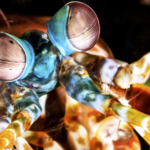News, MANTIS SHRIMP EYES INSPIRE NEW OPTICAL SENSOR
The creators of the new light sensors got their inspiration from the eyes of mantis shrimp, which are exceptionally good at accurately capturing subtle gradations of color. So, the researchers created an organic electronic sensor that mimics the mantis shrimp’s eye. It’s called the Stomatopod Inspired Multispectral and POLarization sensitive (SIMPOL) sensor. And, yes, stomatopod is the fancy name for mantis shrimp. The researchers developed a prototype SIMPOL sensor that can simultaneously register four spectral channels and three polarization channels. In comparison, the charge-coupled devices used in smartphones have only three spectral imaging sensors, which detect red, green, and blue; and only two polarization channels. In addition, the SIMPOL prototype can measure the four color channels and three polarization channels at one point, whereas CCDs rely on imaging sensors spread across several points. While only a proof of concept, the researchers used modeling simulations to determine that the design could be used to create detectors capable of sensing up to 15 spatially registered spectral channels.
Learn about our two Decals!
 Click here to find out more about our Fall Bioinspired Design Decal and our Spring Bioinspired Design in Action Decal – ALL MAJORS are welcome.
Click here to find out more about our Fall Bioinspired Design Decal and our Spring Bioinspired Design in Action Decal – ALL MAJORS are welcome.Berkeley BioDesign Community
 Click here to learn about the BioD: Bio-Inspired Design @ Berkeley student organization or here to signup for more info.
Click here to learn about the BioD: Bio-Inspired Design @ Berkeley student organization or here to signup for more info.Search
Student Login




I imagine that the neurological circuits underlying these processes are governed by both 2d spacing maps with their brains as…
to reduce the impact of car accidents, it may be possible to study the force diverting physics of cockroaches to…
you see this type of head-bobbing stability in many avian creatures related to pigeons like chickens. the head ability to…
not like they taught horses how to run! this is an example of convergent evolution where both sea creatures and…
The brain functions in a similar way with neuronal connections. our brains are able to utilize the multiplicity of connections…